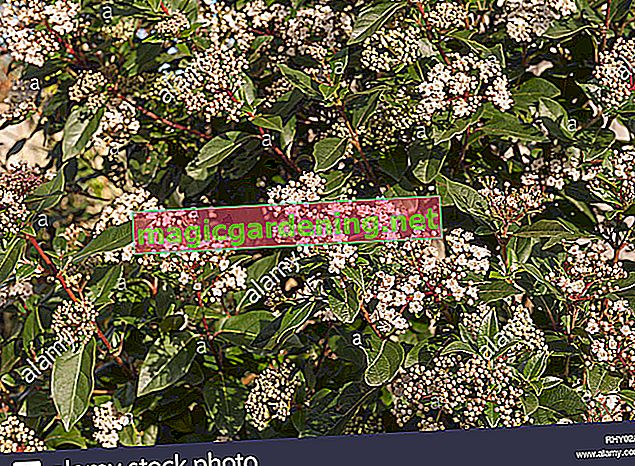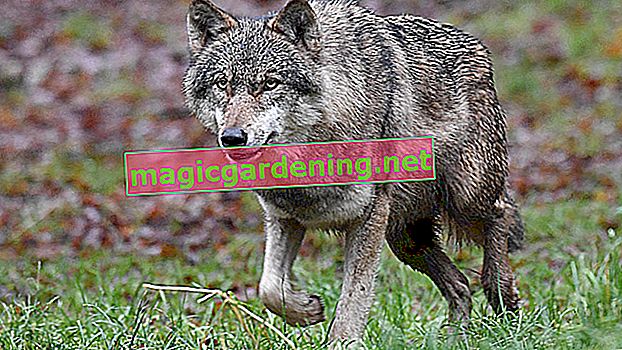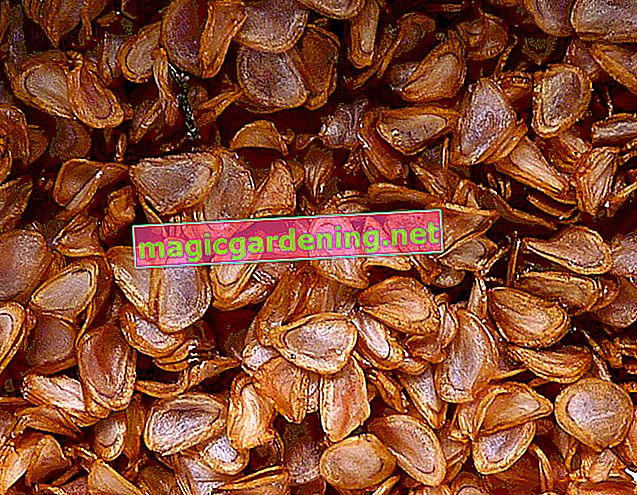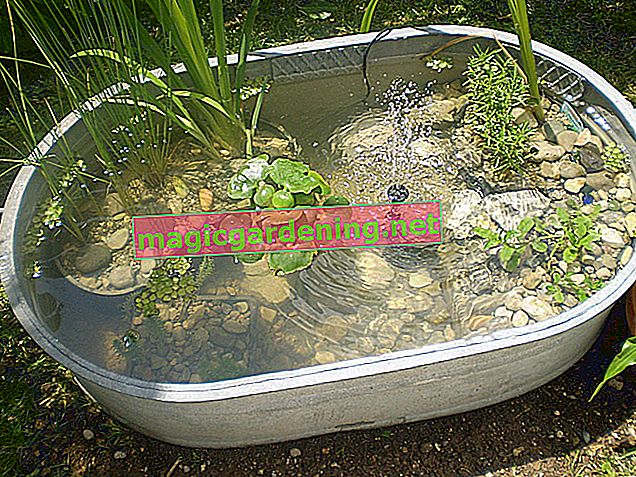
Plant Viburnum tinus correctly
In the open field, plant a Mediterranean snowball in a sunny, warm and sheltered location. Choose a mild day between mid and late May to deeply loosen up the humus rich, nutrient-rich soil. The planting pit is about twice as large as the root ball. Add compost, horn shavings (€ 6.39 at Amazon *) and a little sand to the excavation. Position the potted young plant in the planting hole so that the root ball is flush with the surface at the end. After the pit has been filled with the enriched substrate, press the earth and water. A mulch layer of leaves, lawn clippings or bark mulch keeps the soil warm and moist for longer.
also read
- Viburnum tinus: when is the flowering time coming?
- Is Viburnum Tinus Poisonous? The facts!
- Viburnum tinus: This location awakens feelings of happiness!
Care tips
An evergreen snowball owes its popularity not least to the following uncomplicated care program:
- Keep the soil constantly slightly moist all year round with occasional drying
- Outdoor shrubs fertilize with compost in March / April and June / July
- Apply a liquid fertilizer in the bucket every 14 days from March to September
- Light topiary if necessary immediately after flowering, including thorough thinning
Without careful winter protection, an evergreen snowball rarely gets through the cold season unscathed. Put a breathable fleece hood over the ornamental wood and cover the substrate with leaves, straw or coniferous branches. Wrap the buckets with foil and slide a block of wood underneath.
Continue reading
Which location is suitable?
Evergreen snowball delights us with a high level of location tolerance. The Mediterranean ornamental wood thrives excellently in full sun to partially shaded places. A warm, protected location in a mild wine-growing climate is advantageous, whereby the shrub benefits from its extreme heat tolerance. A Viburnum tinus likes to spread its roots in well-drained soil, humic and moderately dry to fresh and moist.
Continue reading
What soil does the plant need?
In the open air, an evergreen snowball prefers fresh, nutrient-rich and humus-rich soil. A sandy-loamy earth with first-class drainage is ideal for the requirements. For cultivation in the tub, we recommend a high-quality, structurally stable substrate based on compost. When buying peat-rich products, ignore them, as these are not suitable for long-term care of the slowly growing Mediterranean snowball.
What is the best time to plant?
A snowball pulled in the container can be planted in the tub at any time of the year. For cultivation outdoors, we recommend spring as the optimal planting time. When frosty nights are no longer to be expected from the beginning / middle of May, the Mediterranean snowball will find the best framework conditions to take root until winter.
When is the flowering time?
The type of cultivation largely determines the flowering time. If an evergreen snowball thrives in the sheltered ambience of the winter garden, it puts on its magnificent flower dress between November and February. If the ornamental wood is in the limelight in the garden or on the balcony, the numerous buds open between January and April - depending on the weather conditions.
Continue reading
Cut viburnum tinus correctly
The rounded, compact crown creates an evergreen snowball naturally. The gardener's only task is to maintain the shape and regular thinning. How to do it right:
- Put on gloves to avoid skin contact with the toxic plant sap
- Shorten shoots that are too long immediately after flowering
- Place the scissors just above an outwardly pointing leaf knot
- Cut off dead branches at the base
Give a Mediterranean snowball 2 to 3 years to develop its natural silhouette before pruning for the first time. Due to the slow growth, a topiary is only required every few years anyway. Individual, nasal shoots can be cut off at any time. Thorough thinning after the flowering period, on the other hand, is part of the annual maintenance program.
Continue reading
Pour Viburnum tinus
In the best case, the water balance is based on a slightly moist substrate with the surface drying out in the meantime. Do not water a bay-leaved snowball until the soil feels dry in the top 1-2 cm. Avoid the formation of waterlogging, as the ornamental wood reacts to this with root rot.
Fertilize Viburnum tinus properly
An evergreen snowball outdoors receives an organic fertilizer such as compost, bark humus, horn shavings or guano granulate in March / April and June / July. In pot culture, we recommend the application of liquid fertilizer for flowering shrubs every 2 weeks from March to September.
Overwinter
In mild, sheltered locations, an evergreen snowball with winter protection will get through the cold season in good health. This applies both to the field and to the bucket. Here are a few precautions to do right:
- Put a breathable fleece over the ornamental shrub before the first frost
- Cover the soil and substrate thickly with leaves and brushwood
- Place buckets on wood or styrofoam in front of the south wall of the house
Where space allows, carry the planter to a bright winter area with temperatures of 5 to 8 degrees Celsius. Please keep in mind that the ornamental shrub will continue to evaporate moisture. Water the bed and pot from time to time so that the soil or substrate has a minimal moisture content.
Increase Viburnum tinus
If an evergreen snowball is fully in the juice, cut half-woody, non-flowering head cuttings with a length of 10-15 cm. In the lower part, defoliated and planted in pots with poor substrate, the shoots quickly take root. In the partially shaded, warm window seat you can care for the cuttings until next spring. Once a vital root system has developed, repot your pupils in normal substrate, enriched with a little sand or lava granulate. (€ 10.95 at Amazon *) In May, place the young plants outdoors in a sunny, warm location in the permeable, nutrient-rich soil.
Is Viburnum Tinus Poisonous?
An evergreen snowball is moderately poisonous in all parts and therefore unfortunately not suitable for cultivation in the family garden. The blue-black berries are too seductive to be tasted by curious children. Intentional and unintentional consumption causes typical symptoms of poisoning such as nausea, vomiting and cramps in humans and animals.
Continue reading
Nice varieties
- Eva Price: Compact dwarf shrub, blooming profusely in a delicate white-pink; ideal for keeping pots; 100-200 cm
- Purpurea: The variety impresses with green, purple-tinged leaves and pinkish-white flower umbels; 150-200 cm
- French White: Vigorous, evergreen snowball with pure white flowers in late winter; 150-200 cm
- Exbury Form: Premium variety with fragrant flowers, shiny leaves and dark fruit decorations; 250-300 cm
- Variegatum: multicolored, evergreen snowball with pink buds, white flowers and blue berries; 200-250 cm








